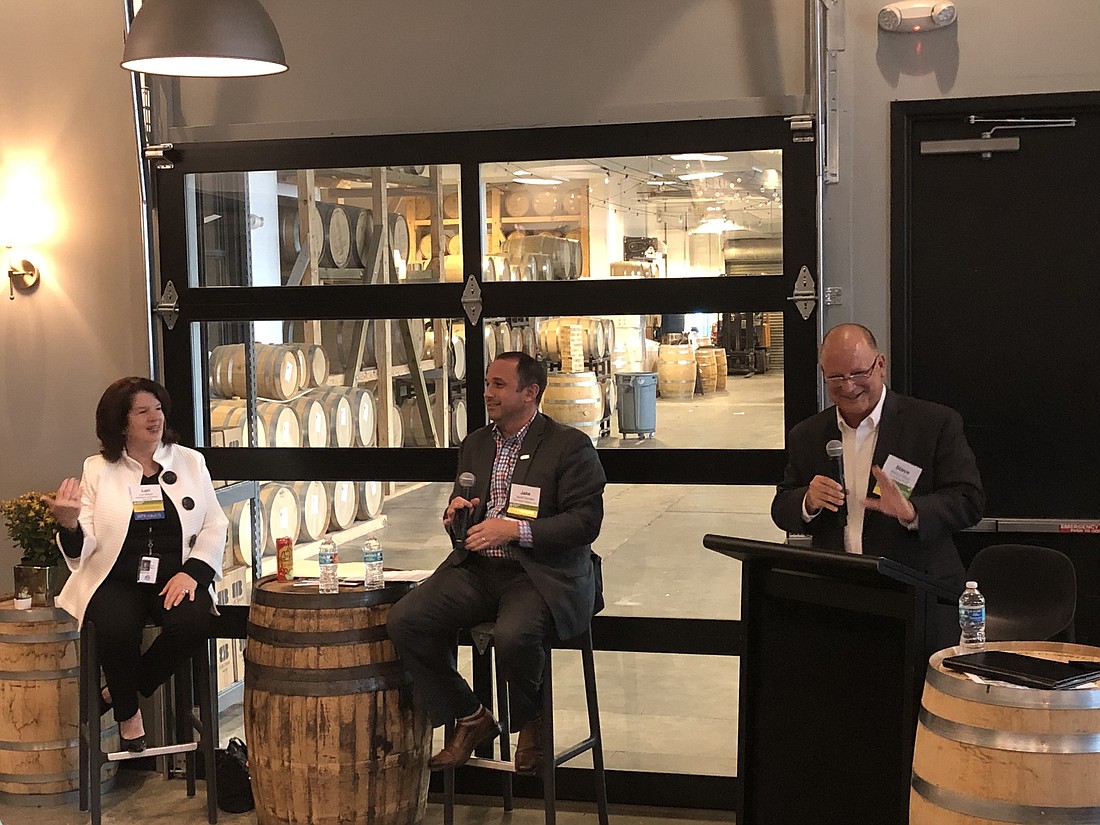
Downtown Investment Authority CEO Lori Boyer says three criteria — capital expenditure, density and neighborhood impact— should be an investor’s focus when considering a Downtown development project.
Boyer discussed marketing and growing the city’s Downtown during an Urban Land Institute North Florida panel discussion Thursday at Manifest Distilling in the Sports and Entertainment District.
Speakers included Downtown Vision CEO Jake Gordon and event moderator Scott Kelley, TIAA Bank vice president of community development and lending.
Boyer said she weighs the impact of a project beyond the number of jobs it creates. For both commercial and residential Downtown developments, Boyer told the ULI crowd the ancillary business activity it spurs is as important as the direct impact.
“Yes, they may bring a number of residents but they also spark a whole neighborhood of surrounding developments, something that creates energy in the area and does something more than just their physical site,” Boyer said.
Boyer said another key factor is a development’s density.
“Personally, I am interested in a much more dense projects, whatever it is, that doesn’t use as much of our valuable Downtown land. There’s a limited resource in how much land we have,” she said.
The tendency for property owners and developers to want a dedicated parking structure for their tenants as part of a development takes space that could be used for retail, restaurants and other businesses, she said.
The DIA CEO thinks creating a shuttle service for Downtown workers from existing parking spaces could help solve that problem.
A shuttle service is a component of an Oct. 8 unsolicited proposal to the DIA by Elite Parking Services of America Inc. to privatize the management of all Downtown parking. Boyer will evaluate the plan, which would grant Elite a 30-year lease.
Recently resigned DIA board member Dane Grey is Elite’s chief executive officer.
Manifest Distilling co-founder Scott Kennelly said parking availability in the Sports and Entertainment District is one of the two biggest impediments to his business.
The distilling operation opened in September 2016 with the anticipation that events and nearby TIAA Bank Field and Daily’s Place would generate foot traffic for Manifest’s tasting room and retail space.
“We hoped to have a lot of people walk in here, buy bottles, try our spirits and tour. That’s worked out for the most part,” Kennelly said. “What we’ve found is a lot of people come Downtown, they go to the events and they leave.”
Kennelly said he likes what the DIA and city are doing to bring larger development projects into Downtown, but he wants the authority to put more emphasis on incentivizing small businesses.
While he said Jacksonville Jaguars owner Shad Khan’s proposed $450 million mixed-use Lot J would be a “game changer” for the Sports and Entertainment District, Kennelly said manufacturing is the only sector that works in the area today.
He said there’s not enough traffic for most restaurants and retail stores.
“I think if we get a critical mass of coffee shops, retail shops, restaurants that are somewhat subsidized or given a leg up by those groups then, ultimately, the bigger projects will come, people will come,” Kennelly said. “When we moved down here, we got nothing. We were outside of the zone at that time.”
Boyer said she is working on plans beyond the DIA’s existing retail enhancement grant program to bring more restaurants and shops into Downtown.
Boyer and Gordon outlined their actions to market Downtown to outside investors and prospective residents.
A joint DIA-DVI venture that will launch by early 2020 is Invest DTJax — a “Zillow-type” online platform where real estate brokers and city agencies like DIA and the Jacksonville Transportation Authority can upload their available property portfolios.
“The idea is to provide a clearinghouse of information for someone who may want to invest in Downtown,” Boyer said.
The DIA is redesigning its website to make it easier to use, Boyer said.
The DIA’s efforts to turn some Downtown streets from one-way to two-way also was raised as a way to ease access to Downtown retail and businesses.
City leaders have been discussing turning Downtown streets to two-way for nearly six years. Boyer hopes conversion will begin with Adams and Forsyth streets in fiscal year 2019-20.